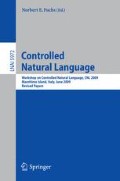Abstract
The “Semantics of Business Vocabulary and Business Rules” (SBVR 1.0) is one of the initial specifications in the OMG’s family of business-focused specifications. SBVR covers two aspects: Vocabulary (natural language ontology) and Rules (elements of guidance that govern actions). However, SBVR does not standardize any particular language for expressing vocabularies and rules. Instead, SBVR uses ‘semantic formulation’, which is a way of describing the semantic structure of statements and definitions. This approach of specifying structures of meaning, with its sound theoretical foundation of formal logic, provides a formal, language-independent means for capturing the semantics of a community’s body of shared meanings. By taking this approach, SBVR can support multiple forms of representation.
Access this chapter
Tax calculation will be finalised at checkout
Purchases are for personal use only
Preview
Unable to display preview. Download preview PDF.
References
Business Rule Solutions: BRS RuleSpeak® Practitioner’s Kit. Business Rule Solutions, LLC (2001-2004), http://www.rulespeak.com
Clark, P., Harrison, P., Murray, W., Thompson, J.: Naturalness vs. Predictability: A Key Debate in Controlled Languages. In: Fuchs, N.E. (ed.) Pre-Proceedings Workshop on Controlled Natural Language, Marettimo Island (2009)
Girle, R.A.: Modal Logics and Philosophy. McGill-Queen’s University Press (2000)
Halpin, T.A., Girle, R.A.: Deductive Logic, 2nd edn. Logiqpress, Brisbane (1981)
Halpin, T.A.: Information Modeling and Higher-Order Types. In: Grundspenkis, J., Kirkova, M. (eds.) Proc. CAiSE 2004 Workshops, vol. 1, pp. 233–248. Riga Tech. University (2004), http://www.orm.net/pdf/EMMSAD2004.pdf
Halpin, T.A.: Object-Role Modeling (ORM/NIAM): An Overview. Springer, San Francisco (2000), http://www.orm.net/pdf/springer.pdf
International Organization for Standardization (ISO): Terminology work — Vocabulary - Part 1: Theory and Application. English/French ed., ISO (2000)
International Organization for Standardization (ISO): Information technology — Common Logic (CL) — A Framework for a Family of Logic-Based Languages, ISO (2005)
Larson, R., Segal, G.: Knowledge of Meaning: An Introduction to Semantic Theory. The MIT Press, Cambridge (1995)
Object Management Group (OMG): Date-Time Foundation Vocabulary, Request for Proposal. OMG document bmi/2008-03-02, http://www.omg.org/techprocess/meetings/schedule/Date-Time_Foundation_Vocabulary_RFP.html
Object Management Group (OMG): Semantics of Business Vocabulary and Business Rules (SBVR), v1.0. OMG (January 2008), http://www.omg.org/spec/SBVR/1.0/PDF
Nijssen, S., Bijlsma, R.: A Conceptual Structure of Knowledge as a Basis for Instructional Designs. In: Kinshuk, R., Koper, P., Kommers, P., Kirschner, D., Sampson, G., Didderen, W.E. (eds.) ICALT 2006, IEEE: 6th Int. Conf. on Advanced Learning Technologies, pp. 7–9. IEEE, Los Alamitos (2006)
Zalta, E.N. (ed.): Stanford Encyclopedia of Philosophy. The Metaphysics Research Lab, Center for the Study of Language and Information. Stanford University, http://plato.stanford.edu/
Author information
Authors and Affiliations
Editor information
Editors and Affiliations
Rights and permissions
Copyright information
© 2010 Springer-Verlag Berlin Heidelberg
About this paper
Cite this paper
Spreeuwenberg, S., Healy, K.A. (2010). SBVR’s Approach to Controlled Natural Language. In: Fuchs, N.E. (eds) Controlled Natural Language. CNL 2009. Lecture Notes in Computer Science(), vol 5972. Springer, Berlin, Heidelberg. https://doi.org/10.1007/978-3-642-14418-9_10
Download citation
DOI: https://doi.org/10.1007/978-3-642-14418-9_10
Publisher Name: Springer, Berlin, Heidelberg
Print ISBN: 978-3-642-14417-2
Online ISBN: 978-3-642-14418-9
eBook Packages: Computer ScienceComputer Science (R0)

